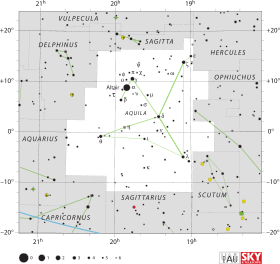R Aquilae
| Ascension droite | 19h 06m 22,2514s |
|---|---|
| Déclinaison | +08° 13′ 48,007″ |
| Constellation | Aigle |
| Magnitude apparente | 5,3 - 12,0[1] |
Localisation dans la constellation : Aigle | |
| Type spectral | M6.5-9e[2] |
|---|---|
| Indice U-B | 0,37[2] |
| Indice B-V | 1,60[2] |
| Variabilité | Mira[3] |
| Vitesse radiale | 34,60 km/s[2] |
|---|---|
| Mouvement propre |
μα = 3,79 mas/a[2] μδ = −67,01 mas/a[2] |
| Parallaxe | 2,37 ± 0,87 mas[2] |
| Distance |
? al (214+45 −32[4] pc) |
| Masse | 1,0 M☉[4] |
|---|---|
| Rayon | 259 ± 67 R☉[5] |
| Luminosité | 3 470 ± 50 L☉[4] |
| Température | 3 000 ± 300 K[4] |
Désignations

R Aquilae est une étoile variable de type Mira de la constellation de l'Aigle. Sa magnitude apparente varie entre 5,5 et 12 sur une période d'environ 270 jours[3]. La période était supérieure à 300 jours la première fois qu'elle fut observée et a décliné constamment depuis[6].
Références
[modifier | modifier le code]- N. N. Samus, O. V. Durlevich et al., « VizieR Online Data Catalog: General Catalogue of Variable Stars (Samus+ 2007-2013) », VizieR On-line Data Catalog: B/gcvs. Originally published in: 2009yCat....102025S, vol. 1, (Bibcode 2009yCat....102025S)
- (en) V* R Aql -- OH/IR star sur la base de données Simbad du Centre de données astronomiques de Strasbourg.
- VSX et Sebastian Otero, « R Aquilae », AAVSO Website, American Association of Variable Star Observers, (consulté le )
- R. Zhao-Geisler, A. Quirrenbach, R. Köhler et B. Lopez, « Dust and molecular shells in asymptotic giant branch stars », Astronomy & Astrophysics, vol. 545, , A56 (DOI 10.1051/0004-6361/201118150, Bibcode 2012A&A...545A..56Z, arXiv 1207.3767)
- G. T. Van Belle, R. R. Thompson et M. J. Creech-Eakman, « Angular Size Measurements of Mira Variable Stars at 2.2 Microns. II », The Astronomical Journal, vol. 124, no 3, , p. 1706 (DOI 10.1086/342282, Bibcode 2002AJ....124.1706V, arXiv astro-ph/0210167)
- J. Greaves et J. J. Howarth, « Further investigations of R Aquilae », Journal of the British Astronomical Association, vol. 110, no 3, , p. 131–142 (Bibcode 2000JBAA..110..131G)
Liens externes
[modifier | modifier le code]- (en) V* R Aql -- OH/IR star sur la base de données Simbad du Centre de données astronomiques de Strasbourg.
- (en) Bright Star Catalogue, « HR 7243 », sur Alcyone
Text is available under the CC BY-SA 4.0 license; additional terms may apply.
Images, videos and audio are available under their respective licenses.

